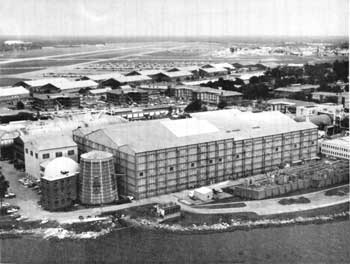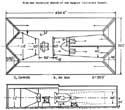.gif)
|
Man in Space
A National Historic Landmark Theme Study |

|
|
National Advisory Committee for Aeronautics Wind Tunnels |

Exterior view of Full Scale Tunnel, 1981.
(Courtesy of NASA, NASA/Langley Research Center Facilities Office)
Full Scale Tunnel
| Name: | 30-by 60-Foot Tunnel (Full Scale Tunnel) |
| Location: | Langley Research Center, Hampton, Virginia |
| Owner: | National Aeronautics and Space Administration (NASA) |
| Condition: | Excellent, altered, original site (1931) |
| Builder/Architect: | Smith J. DeFrance |
| Dates: | 1931-Present |
DESCRIPTION
The Full Scale Tunnel is in building 643 in the East Area of Langley Research Center.
The general arrangement of the Full Scale Tunnel is shown in Appendix 1 at the rear of this report. The tunnel is a double return flow type with an open throat having a horizontal dimension of 60 feet and a vertical dimension of 30 feet. On either side of the test chamber is a return passage 50 feet wide, with a height varying from 46 to 72 feet. The entire equipment is housed in the structure, the outside walls of which serve as the outer walls of the return passages. The over-all length of the tunnel is 434 feet by 222 feet and the maximum height is 97 feet. The framework is on structural steel and the walls and roof are of 5/16-inch corrugated cement asbestos sheets. The entrance and exit cones are constructed of 2-inch wood planking, attached to a steel frame and covered on the inside with galvanized sheet metal as protection against fire. [1]
The test section in the open throat is 30 feet high and 60 feet wide and can accommodate airplanes or models having spans to about 40 feet. The tunnel is powered by two four-blade, 35.5 foot diameter fans, each driven by a 4000-horsepower electric motor. Airflow from the dual propellers is split right and left into two streams; doubling back between the test section and the building's wall, the streams are reunited prior to entering the throat of the test section.
The maximum air-speed of the tunnel is about 100 mph. When this tunnel was first placed in operation in 1931, its maximum air-speed was equal to the top speed of many airplanes then flying. Since then, not only has the maximum speed of airplanes far surpassed that of the tunnel, but transonic and supersonic airplanes operate in realms into which low-speed data cannot be extrapolated. The design of these airplanes however, has required wing shapes and airfoil sections that sometimes result in poor low speed characteristics. The Full Scale Tunnel is well suited to investigate means of alleviating these low speed problems because full or large scale hardware can be used, and the model or airplane is readily accessible. [2]
In addition to the testing capabilities of extensive flow measurement and visualization for large scale-models, the tunnel is equipped with shielded struts for six-component scale balance testing, and can also be used for free-flight testing of subscale models. These tests are particularly suited to the study of high-angle-of-attack flight dynamics for advanced fighter configurations. [3]
The Full Scale Tunnel was upgraded in 1973 and is scheduled to be upgraded in 1984. Work in both cases primarily involved work done on the electric motors that power the fans. At the current time, principal research for this facility is directed at the study of the low-speed aerodynamics, static and dynamic stability and control, and associated flow characteristics of military, general aviation, and commuter aircraft. [4]
STATEMENT OF SIGNIFICANCE
By 1929 the original NACA Langley wind tunnel complex was completed and turning out useful high quality aerodynamic research data. In spite of this achievement NACA engineers realized that there was a gap in their wind tunnel inventory. They needed a full scale wind tunnel.
Although the Variable Density Tunnel gave NACA engineers confidence in scaling up test results from models, several research areas could be explored only with full-scale models or with actual aircraft. The VDT was limited when the aerodynamic characteristics of a complete airplane were desired because it was practically impossible to build a model of the required size that is a true reproduction of a complete airplane. This difficulty is increased by the requirement that the model withstand large forces. Some of the questions that needed to be answered involved solving drag penalties due to external struts, surface gaps, air leaks, and engine cooling insulation. These questions could only be answered by using full scale aircraft. Models simply would not work. Previous experience with the Propeller Research Tunnel, which had a large scale test section, gave NACA engineers the confidence to attempt to build the Full Scale Tunnel.
Under the leadership of Smith J. De France, the design of the Full Scale Wind Tunnel began at Langley in 1929. With funds appropriated before the start of the Depression, NACA was able to buy materials and labor at bargain prices. In addition a large pool of talented but now unemployed aeronautical engineers was available to work on the project. The work progressed quickly and by 1931 the tunnel was complete.
The significance of the Full Scale Tunnel was immediately apparent to NACA engineers. Drag tests in the tunnel indicated surprisingly large performance penalties from external struts and other exposed aircraft parts. This information had been suspected by NACA engineers for some time but with the completion of the Full Scale Tunnel the engineers now had the data needed to correct the problem. Soon a large procession of military aircraft was dispatched to Langley for drag cleanup tests. Before and during World War II practically every high performance aircraft used by the United States was checked out at the Full Scale Tunnel. The tunnel operated 24 hours a day 7 days a week during the war performing drag cleanup tests for the military. For most of the war the Full Scale Tunnel was the only tunnel in the country and in the world capable of performing these tests. The importance of the tunnel was so evident that the United States built an even larger Full Scale Tunnel at the Ames Research Center in 1944. [5]
The Full Scale Tunnel has proved to be a remarkably adaptive research tool. In recent years modern aircraft of all types have been tested in the tunnel. These aircraft include the Harrier VTOL fighter, the F-16, the American supersonic transport, the X-29A—a forward swept wing experimental fighter, the Space Shuttle, the Lunar Landing Test Vehicle, and many others.
Because of its unique performance the Full Scale Tunnel is of singular importance not only in the area of aeronautical research but also in the theme of support facilities that contributed the American victory in World War II. The superiority of American designed and built fighters and bombers was due in no small part to the testing that these aircraft received in the Full Scale Tunnel.
FOOTNOTES
1. National Advisory Committee for Aeronautics, The N.A.C.A. Full-Scale Wind Tunnel-Technical Report 45 (Washington, D.C.: National Advisory Committee for Aeronautics, 1933), pp. 292-93.
2. National Aeronautics and Space Administration, Langley Test Highlights 1982-Technical Memorandum 84655 (Hampton, Va.: Langley Research Center, 1983), p. 3.
Donald D. Baals and William R. Corliss, Wind Tunnels of NASA (Washington, D.C.: National Aeronautics and Space Administration, 1981), p. 23.
4. Langley Facilities Program Development Office, LaRC Data for Facilities Catalogue (Unpublished Internal Memorandum, August 4, 1983), p. 3.
BIBLIOGRAPHY
Anderton, David A. Sixty Years of Aeronautical Research: 1917-1977. Washington, D.C.: National Aeronautics and Space Administration, 1978.
Anderson, John D. Jr. Introduction to Flight: Its Engineering and History. New York: McGraw Hill Book Company, 1978.
Baals, Donald D. and Corliss, William R. Wind Tunnels of NASA. Washington, D.C.: National Aeronautics and Space Administration, 1981.
Characteristics of Nine Research Wind Tunnels of the Langley Aeronautical Laboratory. Washington, D.C.: National Advisory Committee for Aeronautics, 1957.
Gray, George W. Frontiers of Flight: The Story of NACA Research. New York: Alfred E. Knopf, 1948.
Langley Research Center Facilities Program Development Office. LaRC Data for Facilities Catalogue. Hampton, Va., Unpublished Internal Memorandum, August 4, 1983.
Langley Test Highlights 1982-Technical Memorandum 84655. Hampton, Va.: Langley Research Center, 1983.
N.A.C.A. Full Scale Wind Tunnel Technical Report 459. Washington, D.C.: National Advisory Committee for Aeronautics, 1933.
Pope, Alan and Harper, John J. Low-Speed Wind Tunnel Testing. New York: John Wiley & Sons, 1966.
PHOTOGRAPHS
(click on the above photographs for a more detailed view)
Last Modified: Mon, Jan 8 2001 10:00:00 am PDT
man-in-space/space2.htm






 Top
Top